CRYSTAL RIVER — Kings Bay is awash in seagrass. It floats in green mats on the surface. Kayakers sling it away with their paddles. It hangs on boat lines like strands of pasta drying in the sun. Tourists swoosh it away with their pool noodles while watching Crystal River’s most famous residents – the manatees.
Kings Bay, the spring-fed headwaters of Crystal River, about 80 miles north of Tampa, has sea grass in such abundance that visitors cannot help but comment. Some marvel at it.
“You just don’t see this anywhere else,” said Gwen Hamlin of Tarpon Springs, who recently sailed her catamaran into Kings Bay for a few days of kayaking and relaxing.
Hamlin is right. Fresh seagrass is a rare sight. It is notoriously difficult to reestablish healthy sea grass beds in places where the grass has been depleted. And that is the case in most of Florida.
“It’s safe to say no part of Florida is left unaffected,” marine biologist Jessica Mailliez said. She works for Sea & Shoreline, an aquatic restoration firm based in Winter Garden that has planted more than 1 million seagrass plants since 2014. Her firm is responsible for the astonishing growth of eelgrass in the Crystal River ecosystem. The company has other projects across the state, including pilot projects to work out how best to improve the Indian River system.
“Sea grass is not always easy to grow,” she said, noting that Indian River, with its brackish tidal water and denser population presents more of a challenge than Kings Bay, which is constantly replenished by fresh spring water. The town of Crystal River has about 3,000 residents. Its centerpiece, Kings Bay, is surrounded by hundreds of acres of land and wetlands protected by state and federal agencies.

In the Indian River Lagoon, for example, the loss of sea grass is near-total and has resulted in starvation deaths of about 1,000 manatees since 2020. Red tide and blue-green algae blooms fed by nutrient pollution – mostly fertilizer run-off from farms and yards, sewage and septic leaks — have killed off sea grass throughout the state.
Seagrass is vital for marine ecosystems. Without it, manatees aren’t the only creatures starving. Grass beds provide cover for young fish and sustenance for a large variety of wildlife. When seagrass dies, everything in the water is stressed. Fish, turtles and birds disappear. The entire ecosystem begins to collapse.
This was the case for Crystal River in the 1990s and early 2000s.
A project to eradicate invasive hydrilla in the early 1990s was successful, but left tons of dead hydrilla on the bottom of the river and bay. In 1993, an unnamed storm pushed salt water from the Gulf of Mexico into the freshwater system, killing most of the underwater vegetation that was left. What grew in its place was toxic blue-green algae called lyngbya.
Crystal River was no longer crystal clear. It was murky, mucky and smelly – especially in the upland cut canals where homes line the banks. In 2012, a group of concerned residents formed Save Crystal River to deal with the mess. By 2015, they had convinced the Florida Legislature to fund a pilot project to see if seagrass could be restored.
Grass cannot grow in muck, biologist Mailliez said. It’s too soft. The roots of the grass can’t hold on when, say, a manatee stops by for a snack. The whole plant gets pulled up. So the first step in getting seagrass to grow is to clear out the detritus of decaying plants and algae.
At first, divers tried to remove it by hand, shovel by shovel, one stringy, slimy blob of lyngbya at a time. That was slow and ineffective. The project seemed doomed.
Then Sea & Shoreline developed a vacuum system to suck the muck. Divers held a tube along the bottom, carefully revealing a sandy bottom. To date, the company has cleaned out more than 2 million tons of detritus and lyngbya from canals that feed the bay and river. That gunk was separated from silt in specially designed mesh bags, drained and dried for farm fertilizer.
The water was captured, filtered and returned to the canals free of chemicals that cause algae to bloom.
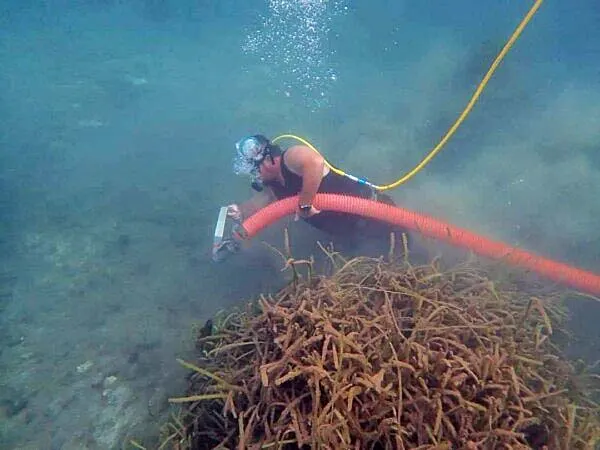
Divers then planted eelgrass shoots into the sediment, where the grass could grow in much the same way as grass grows on land, sending roots into the sturdy substrate, shoots spreading along the silty bottom, and long, leafy blades up toward the surface.
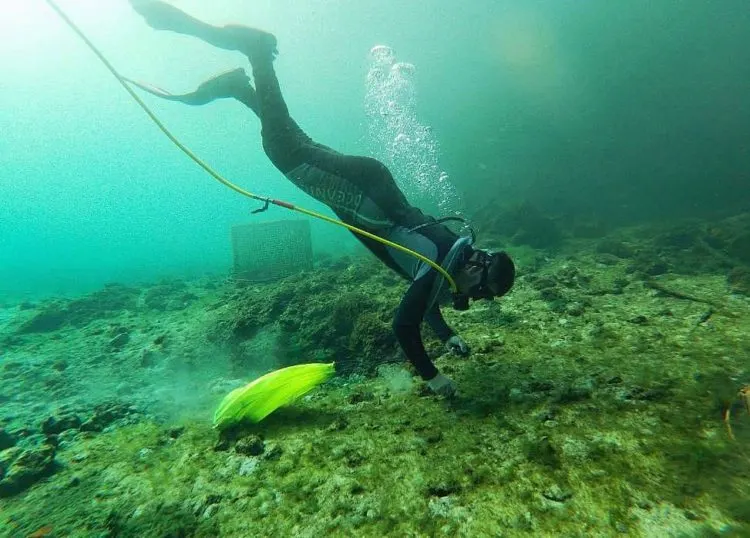
To protect the fledging grass from hungry marine animals, the plantings were covered by cages, which divers checked and maintained until the grass was well established.
This process has been repeated over the past eight years on 92 acres of canals. More than 850 spring vents have been unclogged – some of which were never documented before.
Crystal River is home to more than 70 documented springs, the second-largest system of springs in Florida. Because of this project, it is likely that many previously unknown springs will be documented in the future.
The restoration has been successful beyond the dreams of those who started it.
Biologists estimate that there are now more than 300 acres of healthy eelgrass growing in the 600-acre Kings Bay ecosystem. The eelgrass grows about seven feet in all directions every year.
“This project has been our poster child” for other seagrass restoration in Florida, Mailliez said. “We’ve seen huge species diversity thanks to the success of this project.”
Wildlife restored in the Crystal River
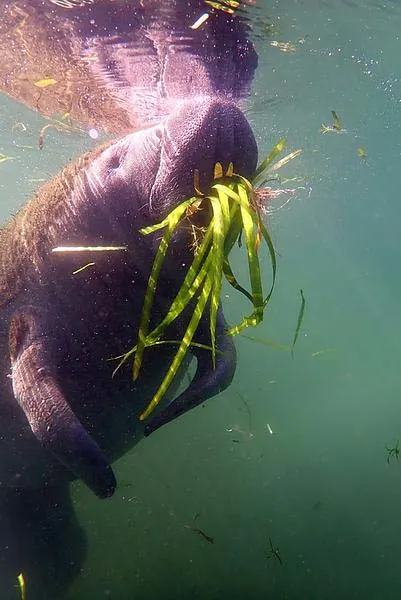
The blue crab fishery, which was completely gone in Crystal River, is back. So is scallop diving. Snook, redfish, bass, drum, freshwater snapper, mullet and all kinds of bait fish and panfish are flourishing. Birds are everywhere — sea birds, wading birds, shorebirds, and migratory flocks in winter.
“There’s plenty of food for them, so they are here, too,” Mailliez said. In annual reports on the Kings Bay Restoration, biological studies have shown about a 75 percent increase in biological diversity year over year – for every year of the project.
The grass itself is making Crystal River and its ecosystem cleaner. Seagrass gobbles up carbon as effectively as trees in a rainforest. Scientists estimate that healthy sea grass beds can sequester as much as 50 times as much carbon per hectare as a tropical forest.
“Seagrass just provides so much oxygen,” biologist Mailliez said. “It pushes out algae growth. You can see the little oxygen bubbles rising from the grass.”
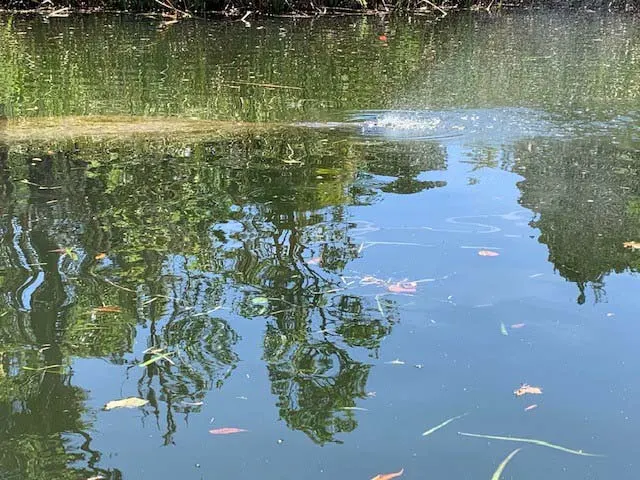
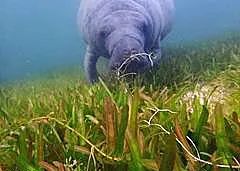
In the winter, manatees migrate to Crystal River’s year-round 72-degree water. In 2022, the count was the highest ever recorded, with 1,016 manatees in Kings Bay. This is most assuredly an under-count, as the aerial count cannot see manatees under tree cover or in murky water. About a tenth of the winter manatee population hangs around all year, so manatee viewing is likely at any time.
Manatees are the reason people visit Crystal River. It is the only place in the United States where it is legal to swim with manatees, although “swimming” is NOT what you do. You float on your tummy, wearing mask and snorkel, keeping your feet up. You passively watch these gentle giants. It is illegal to touch, chase, feed, swim alongside, float directly above or interact in any way with a manatee.
Just look.
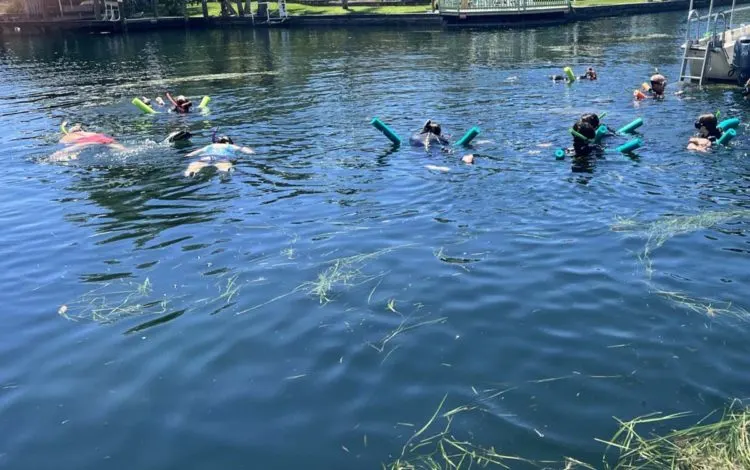
The water in Kings Bay is rarely more than 10 feet deep, shallow enough to provide a close encounter. There’s something strangely calming about these placid, slow-moving, blimp-like creatures. Looking is enough.
“We get a lot a criticism for allowing people in the water with manatees,” said Traci Shoenrock, administrator for the non-profit Save Crystal River. “The entire species does need help. There’s no question about that. But here we have manatees that are happy, healthy and well-fed.”
Three Sisters Springs shored up
The place to see manatees, especially in the winter, is at Three Sisters Springs, a set of three springs connected by a canal to Kings Bay.
During winter months, the population of manatees is so dense it is unsafe to be in the water with them – for manatees and for people — so the springs are closed to watercraft and swimmers from November to April.
The Crystal River National Wildlife Refuge, maintained and overseen by the U.S. Fish and Wildlife Service, enforces several manatee protection zones in the winter, but swimming is still allowed outside these zones.
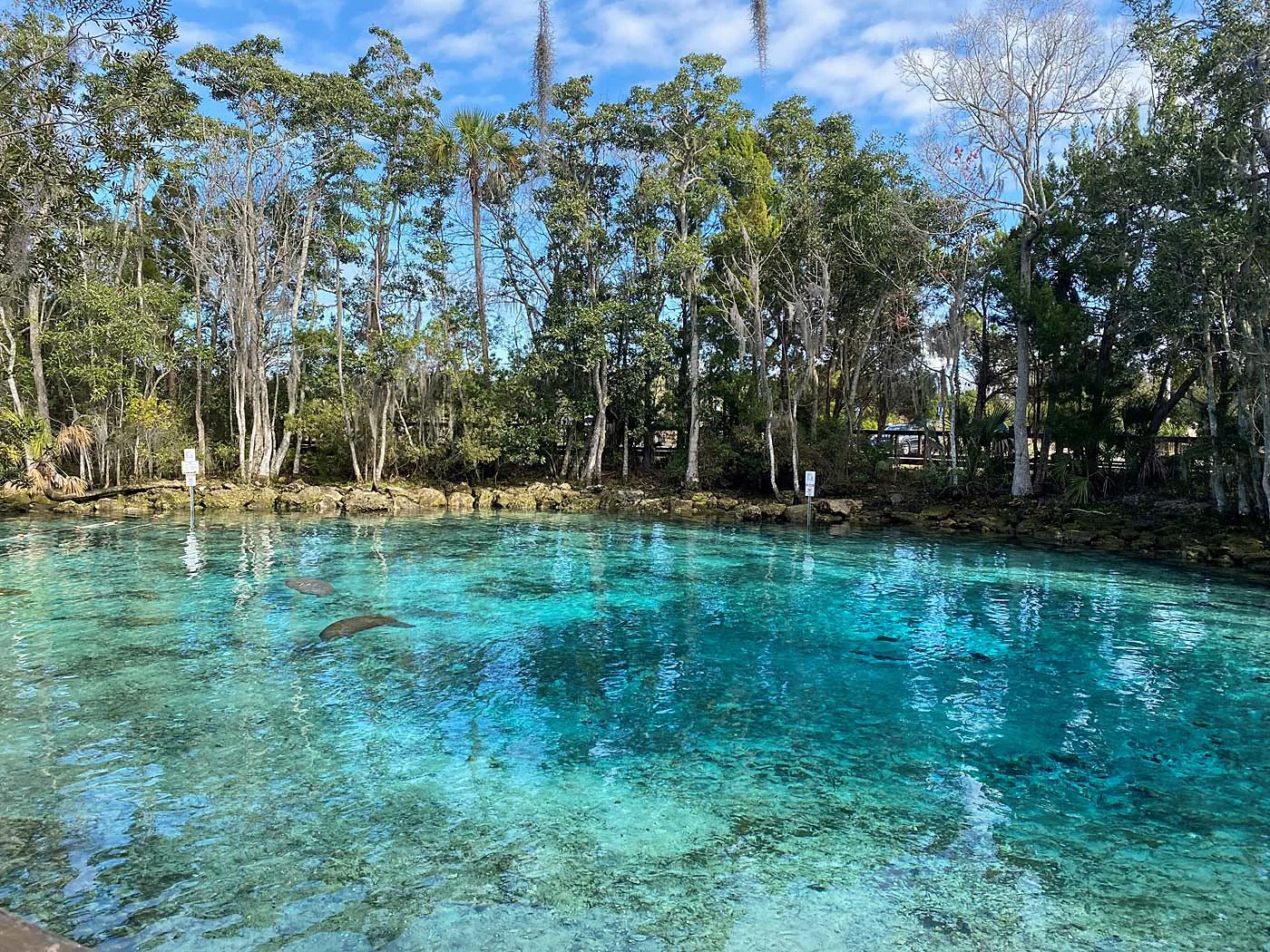
At one time, as many as 500 manatees can crowd into Three Sisters Springs — among the most ever counted in a natural spring anywhere in the world. There is a boardwalk overlooking the springs so that crowds of people can see crowds of manatees. There is no water access to the springs from land — and no land access from the water.
During the summer, it is possible to kayak or swim into the springs to hang out in the cool spring water and visit with whatever resident manatees are there. Over the years, even though it is prohibited, kayakers have tried to tie up and climb out on the banks of the springs. Swimmers have pulled themselves up on the banks, which is also prohibited.
The manatees, too, crowding into such a small area, have helped to wear away the shoreline around the springs.
“In winter, there’s just a lot of them,” said Lizanne Garcia, project manager for the Three Sisters Canal Shoreline Restoration. “They’ll pull themselves out of the water to munch on St. Augustine grass.”
Manatees have also nibbled at tree roots and, in spots, created openings under the bank large enough to hide in. Wind and flooding took their toll as well, and the shoreline was starting to cave in, causing trees to fall and silt and debris to enter the springs.
That amount of dirt and silt going into the springs could have been devastating, so in 2016, the Southwest Florida Water Management District completed a shoreline restoration around the edges of the three springs. Engineers filled in the undercut banks with soil bags, added rocks to stabilize the banks, and planted native plants to keep the shoreline stable.
From April to November 2023, the shoreline got the same treatment all along the spring run — the waterway leading into the springs — and around nearby Idiots Delight Spring, another popular place to observe manatees from the water.
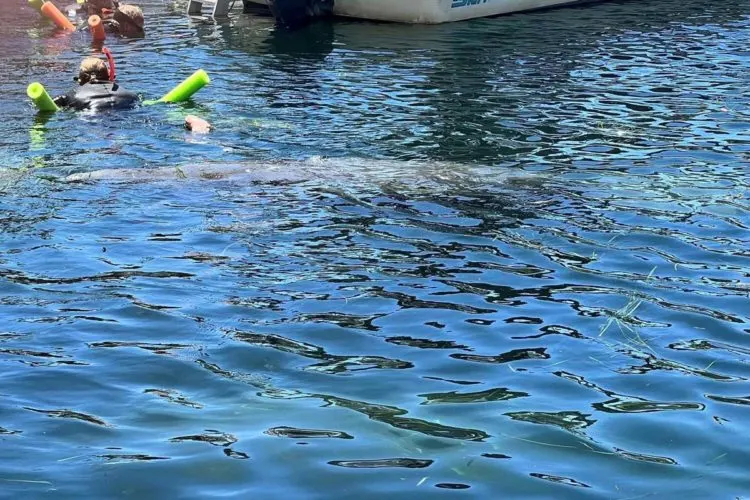
Restoration completed, but not finished
In July 2023, the restoration project’s first ambitious plan was completed: 92 acres cleaned, more than 850 spring vents unclogged, more than 420,000 native eelgrass plants planted, more than 400 million pounds of detritus and blue-green algae removed. About 99 percent of the phosphorus and other harmful nutrients have been filtered out of the water.
The project has been too successful to stop. Another 80 acres of canals, including Miller’s Creek up Crystal River from Kings Bay, will be restored in the next phase. “That is huge,” said Shoenrock, the administrator of Save Crystal River.
Meanwhile, the Southwest Florida Water Management District, which shares responsibility for Three Sisters Springs with the National Wildlife Refuge, has completed several projects since 2015 to prevent pollutants from reaching Kings Bay. All properties in Crystal River previously on septic tanks have been converted to a sewer system. Stormwater treatment projects to keep fertilizer and pollutants from running into the bay have been completed near Hunter Springs and elsewhere, Garcia said.
Visit: Three Sisters Springs Stabilization Project, Southwest Florida Water Management District.
Shoenrock added that it’s an ongoing process to remind residents in the area to avoid using fertilizers and pesticides. “About 80 percent of what we do is education,” she said. The rest is fundraising to support the restoration.
Save Crystal River brought schoolchildren at Crystal River Primary School into the act by giving each classroom a tank in which to tend eelgrass shoots. Fifth graders were invited to plant their shoots in a spring field trip. That educational project has expanded to include every fifth grade in Citrus County, and the classrooms that keep their shoots alive for an entire school year not only learn about the ecosystem, but they also get a pizza party as an incentive to keep their plants growing.
“Teachers are busy and overworked,” Shoenrock said. “We felt we needed to do something to make sure the students stayed focused on those tanks.”
Now that the educational program is established, the restoration as originally planned is complete, and the next phase of restoration is underway.
Shoenrock said Save Crystal River can turn its attention toward other concerns, such as educating boaters on safe anchoring practices to protect the grass, supporting efforts to remove derelict anchored boats in Kings Bay, and calling for increased enforcement of no-wake zones.
“These are concerns,” she said. “We’re trying to find the appropriate middle mark” between manatee and seagrass protection and recreational boating and fishing.
As the ecosystem improves, the pressure of human use also increases. More fish means more fishing boats. More crabs mean more crab traps – which can also slide along the bottom and tear up sea grass. More scallops mean more people diving for scallops – and tearing at grass — during the July-to-September season.
“On weekends we get more traffic in the bay,” Shoenrock said. “On Monday morning it’s very obvious what that does.”
Boat propellers chop the top of the grass. Anchors pull it up from the bottom. Cut grass floats in thick islands on the surface. “We get a lot of complaints about that.”
Boats don’t bear all the blame, though. Manatees also leave bits behind when they munch grass. In the fall, the grass sheds naturally – up to 80 percent of its biomass – and that floats to the surface as well.
Fortunately, the engineers at Sea & Shoreline have a solution for this problem too. They have deployed a custom-designed seagrass collecting machine to scoop up the floating grass from the surface.
“It’s like a big mower on the water,” Sea & Shoreline’s Mailliez said. Except, of course, it’s not mowing. Just collecting.
Floating grass is a problem, she said, because it creates shade, which can slow grass growth, and if sinks to the bottom, it can smother new growth.
The grass that’s scooped up is sent to the Ellie Schiller Homosassa Springs Wildlife State Park, where manatees are in human care for rehabilitation. Seagrass, the natural food of manatees, is far healthier for sick and injured manatees than lettuce. Any excess grass is turned into compost for farming.
For now, grass collection occurs only in the designated restoration area — which isn’t always where wind and tides take the loose grass.
“Everyone wants us to come clear their area,” Mailliez said, “but the grant doesn’t allow that.”
In any case, floating grass is a summer and fall problem. By November, hundreds of manatees will migrate into Crystal River and Kings Bay, and they are the best grass collectors of all.
“They’ll take care of it,” Mailliez said.
Related Florida Rambler stories
Crystal River manatees: How to see, kayak or swim with manatees
Where to see manatees in Florida waters: Try these 17 spots

Vicki McCash Brennan is a veteran journalist, teacher and mentor to high school journalism advisers for the Journalism Education Association. Vicki spent 25 years in the trenches as a reporter and editor for newspapers and magazines. She holds a master’s degree in journalism from the University of Missouri-Columbia. The mother of two grown daughters, Vicki is semi-retired and enjoys bicycling, reading, museums and art galleries, sailing and travel with her husband, Jack.

Mark Sweeney
Wednesday 17th of April 2024
Thank you to all the people that are working hard to keep Crystal River a very special natural wonder. We live along Miller Creek and are very excited what the future will bring with the second phase of this project.
Are there any programs that residents can volunteer for...my wife and I would love to be a part of helping out
Thank you again
Mark & Colette Sweeney
Bonnie Gross
Wednesday 17th of April 2024
There's an active Friends of the Crystal River group. Here's its website: https://friendsofthecrystalriver.org/ The website mentions volunteer opportunities.
Bob Best
Friday 2nd of June 2023
Very well written. My wife and I have lived here since 2004 and have enjoyed almost all of the places mentioned in the article. In the past we have kayaked into 3 Sisters and just sat there watching the bottom and wondered about the absence of food growth on the bottom. We don't go there anymore because we dislike crowds but we do like to hear about the progress being made.
I would offer words of thanks to the many volunteers and corporations that have done so much to redevelop what used to be.